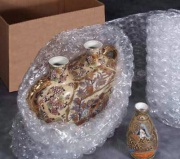Bubble wrap
Description
[Sealed Air] Introduced in 1960 as a trademark of Sealed Air Corporation, Bubble Wrap was formed from a double layer of plastic film containing sealed bubbles, or air pockets, between the layers. The bubbles provide cushioning and are often used to provide some shock and vibration isolation The name is now a generic term given to a range of cellular cushioning sheets made of low-density Polyethylene films. Some brands also have a Polyvinylidene chloride or Polyvinyl chloride film coating. The permeability of the film can result in deflation of the bubbles overtime. Some versions have and additional layer of nylon that prolongs the lifetime of the bubble.
Avoid direct contact between bubble wrap and objects. Bubbles facing out are more prone to breakage, but bubbles faced toward the object can leave distinctive bubble pattern surface marks (especially if no interleaving layer is used). Bubbles tend to break in areas where protection is most required, such as corners and projections. Some of the problems can be mitigated by placing two bubble layers face-to-face, bubble side in. [1]
Synonyms and Related Terms
Bubble Wrap®; Bubblewrap; bubble-wrap; Artifact bubble wrap; bubble pack; bubble paper; air fill; Air Cap; Polycap; Luftpolsterfolie (Deut.)
Applications
Short term, soft packing material often used on paintings or in conjunction with tissue for 3D objects:
- Packing and cushioning material with interleaving material (i.e. tissue, cardboard, poly film); can be applied only to corners or entire object
- Helpful in shock protection for short-term shipping cycles
- Transport, such as in field kits
Personal Risks
Sealed Air Bubble Wrap®: SDS
Collection Risks
- Not for use in long-term-storage
- Bubbles should be used face-out, away from object or in double layers with bubbles facing in
- Avoid direct contact with object
- Bubble pattern may transfer and become imprinted on objects if left in direct contact or held taut against the surface for long periods of time
- Bubbles may deflate over time
- Poly(vinylidene chloride) and Poly(vinyl chloride) films may release hydrochloric acid
- Tissue will not prevent the migration of acid.
Working Properties
Comes on large rolls. Available with perforation to tear sheets.
Exhibit Construction Reviews/Tips/Case Studies
Bubbles should be used face-out, away from object or in double layers, bubbles facing in.[2] Avoid direct contact with object.
More information available at "Preparation, Art Handling, Collections Care Information Network" (PACCIN): Bubble Wrap®
Forms and Sizes
Bubble wrap is usually sold as large rolls with widths up to 72” wide and up to 750 ft long. Bubble sizes can range from 1/4” to 2“ diameter; typically 3/16”, 5/16” and ½”. Perforations optional, every 12” or 48".
Bubble wrap comes in a variety of styles, including antistatic, with an adhesive layer, surface that sticks to itself, or with flat films on both sides.
Comes in a variety of colors, but clear is most common.
Resources and Citations
- Kaela Nurmi, contributed information, MWG group, 2020.
- Bubble Wrap history: https://web.archive.org/web/20100923074021/http://www.bubblewrapturns50today.info/bubble_wrap_facts.pdf
- Sealed Air products: http://www.sealedairprotects.com/eu/en/products/bubblewrap/bubble_wrap.aspx
- AIC Wiki: A Collaborative Knowledge Resource: website
- Preparation, Art Handling, Collections Care Information Network (PACCIN)
- Marjorie Shelley, The Care and Handling of Art Objects, The Metropolitan Museum, New York, 1987
- Pam Hatchfield, Pollutants in the Museum Environment, Archetype Press, London, 2002
- Random House, Webster's Encyclopedic Unabridged Dictionary of the English Language, Grammercy Book, New York, 1997
- The American Heritage Dictionary or Encarta, via Microsoft Bookshelf 98, Microsoft Corp., 1998

